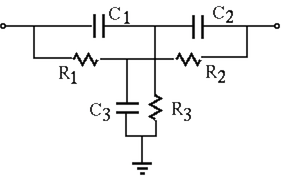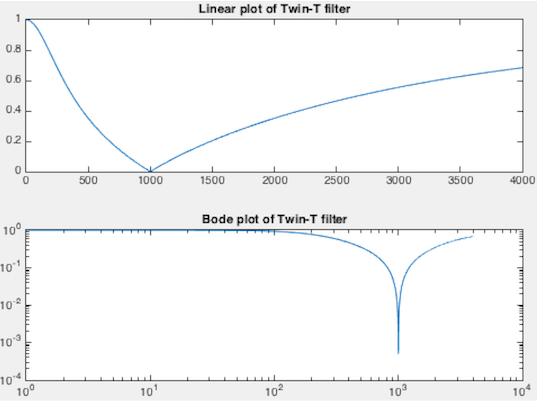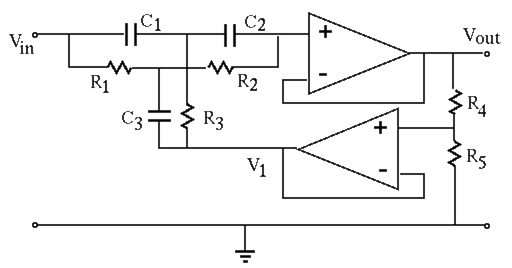
The twin-T filter

The twin-T network is composed of two T-networks:
When the output is open-circuit, i.e., ![]() , the frequency
response function of the twin-T network can be found to be
(see here):
, the frequency
response function of the twin-T network can be found to be
(see here):
 |
|||
 |

When this notch filter is used in a negative feedback loop of an amplifier, it becomes an oscillator.

The active twin-T filter
The bandwidth
![]() may not be narrow
enough for most applications due to the small quality factor
may not be narrow
enough for most applications due to the small quality factor ![]() .
To overcome this problem, an active filter containing two op-amp
followers (with unity gain
.
To overcome this problem, an active filter containing two op-amp
followers (with unity gain ![]() ) can be used to introduce a positive
feedback loop as shown below:
) can be used to introduce a positive
feedback loop as shown below:

Now the common terminal of the twin-T filter is no longer grounded,
instead it is connected a potentiometer, a voltage divider composed
of ![]() and
and ![]() , to form a feedback loop by which a fraction of the
output
, to form a feedback loop by which a fraction of the
output ![]() is fed back:
is fed back:
The input and output of the twin-T network are respectively ![]() and
and
![]() , and they are now related by the frequency response function
, and they are now related by the frequency response function
![]() of the twin-T network:
of the twin-T network:
 |
|||
 |

 |
|||
 |
|||
 |
|||
 |

It can be shown (see here)
that the frequency response function of this active twin-T filter is
 |
|||
 |

The bridged T filter
If in the RCR T-network the vertical capacitor branch is dropped,
i.e., ![]() , the twin-T network becomes a bridged T network. Now
we have
, the twin-T network becomes a bridged T network. Now
we have ![]() , while the CRC T-network is still the same with
, while the CRC T-network is still the same with
![]() , we get:
, we get:

 |
|||
 |
|||
 |
